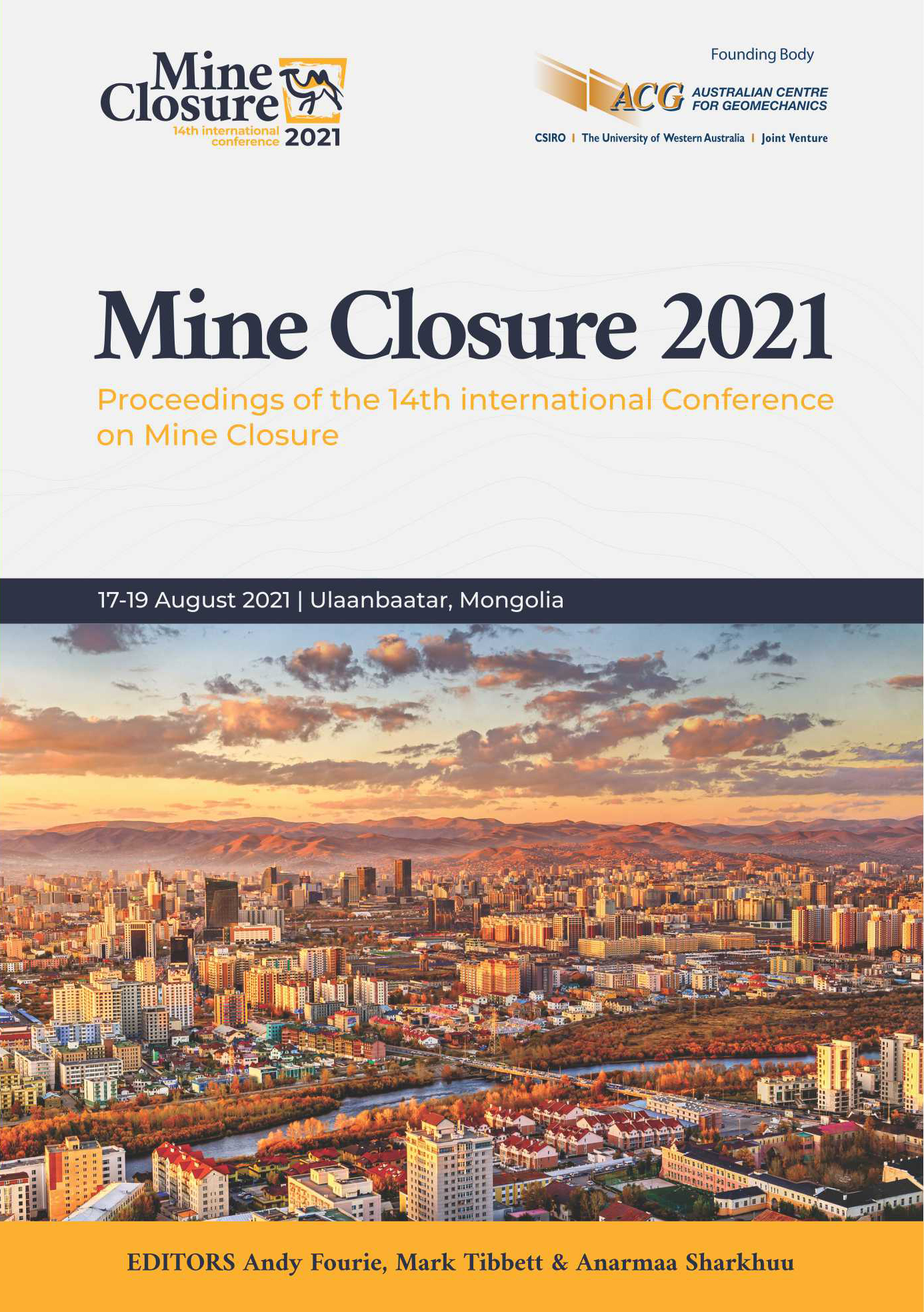Soil organic carbon in rehabilitated coal mine soils as an indicator for soil health

|
Authors: Baumgartl, T; Chan, J; Bucka, F; Pihlap, E |
DOI https://doi.org/10.36487/ACG_repo/2152_121
Cite As:
Baumgartl, T, Chan, J, Bucka, F & Pihlap, E 2021, 'Soil organic carbon in rehabilitated coal mine soils as an indicator for soil health', in AB Fourie, M Tibbett & A Sharkuu (eds), Mine Closure 2021: Proceedings of the 14th International Conference on Mine Closure, QMC Group, Ulaanbaatar, https://doi.org/10.36487/ACG_repo/2152_121
Abstract:
Rehabilitation intends to provide a safe, stable and sustainable environment. Soil health is often used as a parameter, which describes the success of reclamation, the performance of the soil and its associated soil system functions. Reclaimed and therefore young soils are in general deprived of soil organic carbon. They are not in equilibrium with their environment and undergo changes over time, faster than natural and developed soils. Carbon content as a summarising criterion for soil health status can be used as an indicator as it reflects the performance of important soil processes, like water holding capacity, drainage and aeration potential and nutrient supply and storage. It is well established that carbon content affects soil functions like hydraulic conductivity by creating structural elements through aggregation processes. Increasing carbon content leads to increased water infiltration, reduced surface runoff and erosional risks, and increases the exchange rate of gases and improves aeration and has in general positive consequences for microbiological activity. Results from a study of soil covers of different ages emphasise this consequence. The evaluation of the rehabilitation success in coal mining using carbon content is complicated due to the difficulty distinguishing between carbon forms: organic carbon naturally formed by decomposition vs. carbon originating from coal as coal dust or charred material. Furthermore, the assessment of the performance of rehabilitated soils is strongly affected by climatic conditions, which affect the production, decomposition and translocation of organic matter. Litter and dead organic matter from plants are decomposed on the soil surface and incorporated through organisms into the soil profile. Dissolvable organic constituents may be transported with infiltrating water down the profile. Consequently, carbon is primarily concentrated close to the surface. In semi-arid environments the accumulation depth may only be centimetres as was found from a study on the performance of the carbon pool of rehabilitated soils across sites up to 35 years of age. This has implications for the sampling strategy and the assessment of the performance of soils over time. As the carbon content in soils at coal mines can be affected by precipitation and incorporation of coal dust into the soil, the content of new organic carbon representing soil health status can be misleadingly interpreted. Therefore, separation of carbon fractions is necessary to identify the “green” carbon pool (carbon originating from plant litter and residue) as best as possible and extract the correct fraction to assess the performance of soil development. A method has been developed and is presented which allows the separation between the various carbon pools. From the presented study, the following conclusions were drawn: 1) Soil carbon is an easy to measure indicator for the assessment of the performance of soil health of rehabilitated soils; 2) soil functional properties are affected by carbon content and age and hence change with soil development; 3) only green carbon represents soil health and appropriate methodology has to be in place to exclude other carbon pools; 4) carbon storage in rehabilitated soils of semi-arid environments of Australia is below that of natural soils
References:
Agus, C, Putra, PB, Faridah, E, Wulandari, D & Napitupulu, RRP 2016, ‘Organic Carbon Stock and their Dynamics in Rehabilitation Ecosystem Areas of Post Open Coal Mining at Tropical Region’. Procedia Engineer vol. 159, pp. 329–337.
Chan, J, Baumgartl, T, Erskine, P, Peltre, C, Plante, A, 2014a. ‘Quantitative differentiation between coal, black carbon and soil organic matter in a minesoil matrix using thermal analysis techniques’. in EGU General Assembly Conference Abstracts 16, 4697.
Chan, J, Baumgartl, T, Erskine, P, Peltre, C, Plante, A, 2014b. ‘Distinguishing Carbon Fractions in Coalmine Rehabilitated Soils’. In Life of Mine 2014 Conference, Brisbane, QLD, Australia, 16–18 July.
Chan, J, Plante, AF, Peltre, C, Baumgartl, T & Erskine, P 2017, ‘Quantitative differentiation of coal, char and soil organic matter in an Australian coal minesoil’. Thermochimica acta vol. 650, pp. 44–55.
Heanes, DL, 1984, ‘Determination of total organic-C in soils by an improved chromic acid digestion and spectrophotometric procedure’. Communications in Soil Science and Plant Analysis vol. 15, pp. 1191-1213.
Hillel, D, Rosenzweig, C, 2009, ‘Carbon Exchange in the terrestial domain and the role of agriculture. CSA News, V54, N06, 5–11.
Lal, R, 2008, ‘Sequestration of atmospheric CO2 in global carbon pools’. Energ Environ Sci vol. 1, pp. 86–100.
Maraseni, T, Mathers, N, Harms, B, Cockfield, G, Apan, A, & Maroulis, J 2008, ‘Comparing and prediciting soil carbon quantitiesunder different land use systems on the Red Ferrosol soils of southeast Queensland’. Journal of Soil and Water Conservation vol. 63, pp. 250–256.
Ontl, TA & Schulte, LA 2012, ‘Soil Carbon Storage’. Nature Education Knowledge vol. 3, no. 10, pp. 35
Viscarra Rossel, RAV, Webster, R, Bui, EN & Baldock, JA 2014, Baseline map of organic carbon in Australian soil to support national carbon accounting and monitoring under climate change. Global Change Biol vol. 20, pp. 2953–2970.
© Copyright 2024, Australian Centre for Geomechanics (ACG), The University of Western Australia. All rights reserved.
View copyright/legal information
Please direct any queries or error reports to repository-acg@uwa.edu.au
View copyright/legal information
Please direct any queries or error reports to repository-acg@uwa.edu.au
